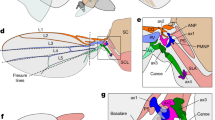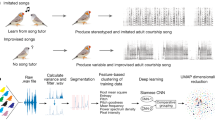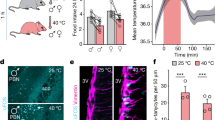Abstract
Understanding the biophysical basis of animal magnetoreception has been one of the greatest challenges in sensory biology. Recently it was discovered that the light-dependent magnetic sense of Drosophila melanogaster is mediated by the ultraviolet (UV)-A/blue light photoreceptor cryptochrome (Cry)1. Here we show, using a transgenic approach, that the photoreceptive, Drosophila-like type 1 Cry and the transcriptionally repressive, vertebrate-like type 2 Cry of the monarch butterfly (Danaus plexippus) can both function in the magnetoreception system of Drosophila and require UV-A/blue light (wavelength below 420 nm) to do so. The lack of magnetic responses for both Cry types at wavelengths above 420 nm does not fit the widely held view that tryptophan triad-generated radical pairs mediate the ability of Cry to sense a magnetic field. We bolster this assessment by using a mutant form of Drosophila and monarch type 1 Cry and confirm that the tryptophan triad pathway is not crucial in magnetic transduction. Together, these results suggest that animal Crys mediate light-dependent magnetoreception through an unconventional photochemical mechanism. This work emphasizes the utility of Drosophila transgenesis for elucidating the precise mechanisms of Cry-mediated magnetosensitivity in insects and also in vertebrates such as migrating birds.
This is a preview of subscription content, access via your institution
Access options
Subscribe to this journal
Receive 51 print issues and online access
$199.00 per year
only $3.90 per issue
Buy this article
- Purchase on Springer Link
- Instant access to full article PDF
Prices may be subject to local taxes which are calculated during checkout




Similar content being viewed by others
References
Gegear, R. J., Casselman, A., Waddell, S. & Reppert, S. M. Cryptochrome mediates light-dependent magnetosensitivity in Drosophila . Nature 454, 1014–1018 (2008)
Wiltschko, W. & Wiltschko, R. Magnetic orientation and magnetoreception in birds and other animals. J. Comp. Physiol. A 191, 675–693 (2005)
Lohmann, K. J., Lohmann, C. M. F. & Putman, N. F. Magnetic maps in animals: nature’s GPS. J. Exp. Biol. 210, 3697–3705 (2007)
Wiltschko, R., Ritz, T., Stapput, K., Thalau, P. & Wiltschko, W. Two different types of light-dependent responses to magnetic fields in birds. Curr. Biol. 15, 1518–1523 (2005)
Phillips, J. B. & Borland, S. C. Wavelength specific effects of light on magnetic compass orientation of the eastern red-spotted newt Notophthalmus viridescens . Ethol. Ecol. Evol. 4, 33–42 (1992)
Rodgers, C. T. & Hore, P. J. Chemical magnetoreception in birds: the radical pair mechanism. Proc. Natl Acad. Sci. USA 106, 353–360 (2009)
Ritz, T., Adem, S. & Schulten, K. A model for photoreceptor-based magnetoreception in birds. Biophys. J. 78, 707–718 (2000)
Maeda, K. et al. Chemical compass model of avian magnetoreception. Nature 453, 387–390 (2008)
Mouritsen, H. & Ritz, T. Magnetoreception and its use in bird navigation. Curr. Opin. Neurobiol. 15, 406–414 (2005)
Zhu, H. S. et al. The two CRYs of the butterfly. Curr. Biol. 15, R953–R954 (2005)
Yuan, Q., Metterville, D., Briscoe, A. D. & Reppert, S. M. Insect cryptochromes: gene duplication and loss define diverse ways to construct insect circadian clocks. Mol. Biol. Evol. 24, 948–955 (2007)
Öztürk, N., Song, S. H., Selby, C. P. & Sancar, A. Animal type 1 cryptochromes: analysis of the redox state of the flavin cofactor by site-directed mutagenesis. J. Biol. Chem. 283, 3256–3263 (2008)
vanVickle-Chavez, S. J. & van Gelder, R. N. Action spectrum of Drosophila cryptochrome. J. Biol. Chem. 282, 10561–10566 (2007)
Ritz, T., Dommer, D. H. & Phillips, J. B. Shedding light on vertebrate magnetoreception. Neuron 34, 503–506 (2002)
Kaneko, M. & Hall, J. C. Neuroanatomy of cells expressing clock genes in Drosophila: transgenic manipulation of the period and timeless genes to mark the perikarya of circadian pacemaker neurons and their projections. J. Comp. Neurol. 422, 66–94 (2000)
Zhu, H. S. et al. Cryptochromes define a novel circadian clock mechanism in monarch butterflies that may underlie sun compass navigation. PLoS Biol. 6, 138–155 (2008)
Tu, D. C., Batten, M. L., Palczewski, K. & Van Gelder, R. N. Nonvisual photoreception in the chick iris. Science 306, 129–131 (2004)
Hoang, N. et al. Human and Drosophila cryptochromes are light activated by flavin photoreduction in living cells. PLoS Biol. 6, 1559–1569 (2008)
Berndt, A. et al. A novel photoreaction mechanism for the circadian blue light photoreceptor Drosophila cryptochrome. J. Biol. Chem. 282, 13011–13021 (2007)
Song, S. H. et al. Formation and function of flavin anion radical in cryptochrome 1 blue-light photoreceptor of monarch butterfly. J. Biol. Chem. 282, 17608–17612 (2007)
Solov’yov, I. A. & Schulten, K. Magnetoreception through cryptochrome may involve superoxide. Biophys. J. 96, 4804–4813 (2009)
Hogben, H. J., Efimova, O., Wagner-Rundell, N., Timmel, C. R. & Hore, P. J. Possible involvement of superoxide and dioxygen with cryptochrome in avian magnetoreception: origin of Zeeman resonances observed by in vivo EPR spectroscopy. Chem. Phys. Lett. 480, 118–122 (2009)
Öztürk, N. et al. Structure and function of animal cryptochromes. Cold Spring Harb. Symp. Quant. Biol. 72, 119–131 (2007)
Yoshii, T., Ahmad, M. & Helfrich-Forster, C. Cryptochrome mediates light-dependent magnetosensitivity of Drosophila’s circadian clock. PLoS Biol. 7, 813–819 (2009)
Stanewsky, R. Genetic analysis of the circadian system in Drosophila melanogaster and mammals. J. Neurobiol. 54, 111–147 (2003)
Rutila, J. E. et al. CYCLE is a second bHLH-PAS clock protein essential for circadian rhythmicity and transcription of Drosophila period and timeless. Cell 93, 805–814 (1998)
Sheeba, V., Gu, H., Sharma, V. K., O’Dowd, D. K. & Holmes, T. C. Circadian- and light-dependent regulation of resting membrane potential and spontaneous action potential firing of Drosophila circadian pacemaker neurons. J. Neurophysiol. 99, 976–988 (2008)
Reppert, S. M. A colorful model of the circadian clock. Cell 124, 233–236 (2006)
Emery, P., So, W. V., Kaneko, M., Hall, J. C. & Rosbash, M. CRY, a Drosophila clock and light-regulated cryptochrome, is a major contributor to circadian rhythm resetting and photosensitivity. Cell 95, 669–679 (1998)
Acknowledgements
We thank Q. Yuan for performing the assays in Fig. 3d and the cryptochrome alignments in Supplementary Fig. 1, and P. Emery, C. Merlin and D. R. Weaver for discussions. This work was supported by a grant from the National Institutes of Health.
Author Contributions All authors contributed to experimental design, execution, data analysis and writing the paper.
Author information
Authors and Affiliations
Corresponding authors
Ethics declarations
Competing interests
The authors declare no competing financial interests.
Supplementary information
Supplementary Information
This file contains Supplementary Figures S1-S3 with Legends and Supplementary References. (PDF 1161 kb)
Rights and permissions
About this article
Cite this article
Gegear, R., Foley, L., Casselman, A. et al. Animal cryptochromes mediate magnetoreception by an unconventional photochemical mechanism. Nature 463, 804–807 (2010). https://doi.org/10.1038/nature08719
Received:
Accepted:
Published:
Issue Date:
DOI: https://doi.org/10.1038/nature08719
This article is cited by
-
Essential elements of radical pair magnetosensitivity in Drosophila
Nature (2023)
-
No evidence for magnetic field effects on the behaviour of Drosophila
Nature (2023)
-
Insect magnetoreception: a Cry for mechanistic insights
Journal of Comparative Physiology A (2023)
-
Radical pairs can explain magnetic field and lithium effects on the circadian clock
Scientific Reports (2022)
-
Cryptochrome 1 mediates light-dependent inclination magnetosensing in monarch butterflies
Nature Communications (2021)
Comments
By submitting a comment you agree to abide by our Terms and Community Guidelines. If you find something abusive or that does not comply with our terms or guidelines please flag it as inappropriate.



